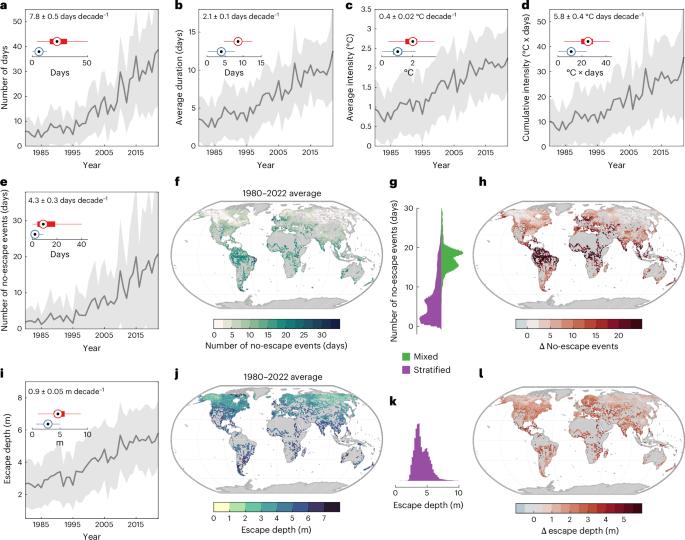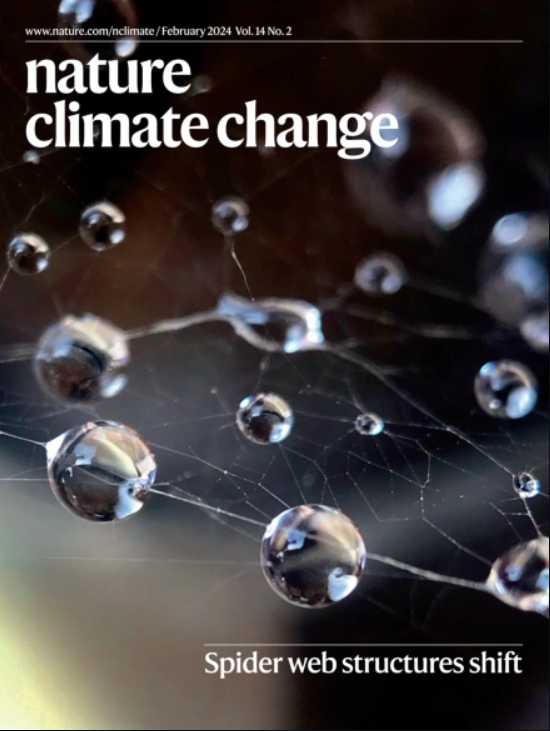Subsurface heatwaves in lakes
IF 27.1
1区 地球科学
Q1 ENVIRONMENTAL SCIENCES
引用次数: 0
Abstract
Lake heatwaves (extreme hot water events) can substantially disrupt aquatic ecosystems. Although surface heatwaves are well studied, their vertical structures within lakes remain largely unexplored. Here we analyse the characteristics of subsurface lake heatwaves (extreme hot events occurring below the surface) using a spatiotemporal modelling framework. Our findings reveal that subsurface heatwaves are frequent, often longer lasting but less intense than surface events. Deep-water heatwaves (bottom heatwaves) have increased in frequency (7.2 days decade−1), duration (2.1 days decade−1) and intensity (0.2 °C days decade−1) over the past 40 years. Moreover, vertically compounding heatwaves, where extreme heat occurs simultaneously at the surface and bottom, have risen by 3.3 days decade−1. By the end of the century, changes in heatwave patterns, particularly under high emissions, are projected to intensify. These findings highlight the need for subsurface monitoring to fully understand and predict the ecological impacts of lake heatwaves. Heatwaves in lakes are increasing with climate change, but are typically studied at the surface; little is known about heatwave dynamics with depth. This study finds subsurface heatwaves last longer, but are less intense than surface heatwaves and have increased in frequency over the past 40 years.


湖泊的地下热浪
湖泊热浪(极端热水事件)可以严重破坏水生生态系统。尽管人们对地表热浪进行了很好的研究,但它们在湖泊中的垂直结构在很大程度上仍未被探索。在这里,我们使用一个时空模型框架分析了地下湖泊热浪(发生在地表以下的极端高温事件)的特征。我们的研究结果表明,地下热浪频繁发生,通常持续时间更长,但强度低于地表事件。在过去40年中,深水热浪(海底热浪)的频率(每十年−1 7.2天)、持续时间(每十年−1 2.1天)和强度(每十年−1 0.2°C天)均有所增加。此外,在地表和底部同时出现极端高温的垂直复合热浪,在10 - 1年增加了3.3天。到本世纪末,预计热浪模式的变化,特别是在高排放的情况下,将会加剧。这些发现强调了地下监测的必要性,以充分了解和预测湖泊热浪的生态影响。
本文章由计算机程序翻译,如有差异,请以英文原文为准。
求助全文
约1分钟内获得全文
求助全文
来源期刊

Nature Climate Change
ENVIRONMENTAL SCIENCES-METEOROLOGY & ATMOSPHERIC SCIENCES
CiteScore
40.30
自引率
1.60%
发文量
267
审稿时长
4-8 weeks
期刊介绍:
Nature Climate Change is dedicated to addressing the scientific challenge of understanding Earth's changing climate and its societal implications. As a monthly journal, it publishes significant and cutting-edge research on the nature, causes, and impacts of global climate change, as well as its implications for the economy, policy, and the world at large.
The journal publishes original research spanning the natural and social sciences, synthesizing interdisciplinary research to provide a comprehensive understanding of climate change. It upholds the high standards set by all Nature-branded journals, ensuring top-tier original research through a fair and rigorous review process, broad readership access, high standards of copy editing and production, rapid publication, and independence from academic societies and other vested interests.
Nature Climate Change serves as a platform for discussion among experts, publishing opinion, analysis, and review articles. It also features Research Highlights to highlight important developments in the field and original reporting from renowned science journalists in the form of feature articles.
Topics covered in the journal include adaptation, atmospheric science, ecology, economics, energy, impacts and vulnerability, mitigation, oceanography, policy, sociology, and sustainability, among others.
 求助内容:
求助内容: 应助结果提醒方式:
应助结果提醒方式:


